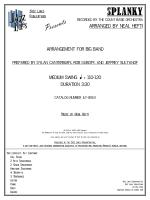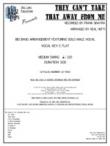SPLANKY
Recorded by the Count Basie Orchestra
Arranged by Neal Hefti, Prepared for Publication by Dylan Canterbury, Rob DuBoff, and Jeffrey Sultanof

Cat #: JLP-8063
$75.00This item usually ships within 1 business day.
Questions?
Please call +1-518-587-1102 or email us.
Edition: Jazz Big Band Arrangement
Description: Swing - Medium
Publisher: Jazz Lines Publications
There are few collaborations in the world of big band jazz that have produced more classic outcomes than those of bandleader Count Basie and arranger Neal Hefti. At the start of their association in 1951, Basie was looking to revive his big band after a period where economics had forced him to downsize his unit to an octet. Hefti, a youthful veteran who had already written for Woody Herman, Buddy Rich, and Charlie Parker, was looking to expand his name in the public eye. When the two brought their highly sympathetic musical personalities together, the result was a completely re-defined sound of the Basie organization, and big band jazz in general, by combining the easy-swinging riff-based style of Basie’s 1930s groups with Hefti’s more contemporary, orchestrated sensibility. Their relationship reached its apex with three albums comprised entirely of Hefti’s arrangements: 1957’s The Atomic Mr. Basie, 1958’s Basie Plays Hefti, and 1962’s On My Way & Shoutin’ Again. These universally-acclaimed classics left the sound of big band jazz permanently altered for the better, revived Basie’s fortunes as a bandleader, and paved the way for Hefti’s transition to the world of scoring for television and film.
Of all of Hefti's arrangements during this fruitful period, Splanky has the most in common with the sound of the original 1930s Basie outlets. The arrangement can be broken down into two distinct parts - the melody, and the shout chorus. Sandwiched inside these parts is a solo section over a concert Db blues. On the original recording, the only soloist is tenor saxophonist Frank Foster, but the arrangement's simplicity lends itself to being opened up as much as you please.
The melody follows a typical Basie piano introduction, and is a now-iconic four measure riff that is repeated three times by muted brass. The saxes interject by repeating the exact same figure as a response. The feel during this portion (and the arrangement in general, for that matter) should be relaxed, but not so much as to fall behind the beat. The shout chorus is equally iconic, with the roaring brass and saxes stating a simple but highly effective melody that is augmented by some thunderous drum fills from Sonny Payne on the original recording.
The entire arrangement is structured as follows: melody twice (first time without saxes), solos, shout chorus twice, melody once, shout chorus once. The arrangement ends in typical Basie fashion - a two-bar piano break, followed by a surprisingly warm final ensemble chord.
2 Alto Saxophones
2 Tenor Saxophones
Baritone Saxophone
4 Trumpets
3 Trombones
Guitar
Piano
Bass
Drums
Trombone 1: Cb5








